The Overlooked Challenges In A Post Pandemic Workplace
“There’s a natural pull, even in these times, not to figure out how to operate in this new world but how to replicate the old world in the new conditions,” said Leslie Perlow, a professor of leadership at Harvard Business School.
“The longer this goes on, my optimism increases because I think people are being forced to figure out innovative ways.”
When we asked customer experience, service, and marketing leaders:
Which of the following challenges have either prevented you from pursuing or impacted the success of your work-from-home initiatives?
36% cited Equipment (quality, costs, inspections, etc.), ranking in the top three responses from sixteen categories, above crucial concerns such as culture, productivity, supervision, training and coaching, protecting customer data and privacy, and more.
When we asked customer experience, service, and marketing leaders:
Which of the following is meaningfully impacting your customer contact performance (including, but not limited to, your situation amid the Coronavirus pandemic)?
38.2% cited Agents [or other front-line employees] lack an integrated desktop for performing tasks across channels, ranking as the number one response among eighteen categories.
The pandemic has had many impacts on technology, influencing consumer behavior, employee productivity, and operational efficiency. But there is one in particular that few are paying attention to, but many are inadvertently experiencing.
A nationwide shortage in computers
Organizations across the United States are facing shortages and long delays, of up to several months, in getting crucial supplies for 2021: laptops and other equipment needs, an Associated Press investigation has found.
The world’s three biggest computer companies, Lenovo, HP, and Dell, have told school districts, for one example, that they have a shortage of nearly 5 million laptops, alone.
This has caused computer equipment to surge in cost, with companies such as best buy raising prices to over $500 on 84 percent of their laptop stock. (Do business leaders and even schools eat the costs of updating technologies, wait half a year to receive them, or leave their employees stranded with outdated or broken technologies?)
The issue is not isolated in the U.S. alone. Organizations worldwide have been running into the same challenge, as companies are demanding to keep social distancing intact and keep the offices and schools remaining empty, to a degree, which has only increased the overall demand for equipment. Online retailers and brick and mortar stores have had their inventory wiped out for laptops, with millions more still needed equipment to perform their job duties to keep the businesses functioning.
The situation gets worse, as there seems to be no end in sight for the laptop shortage to subside any time soon. Businesses will continue to struggle with procuring needed equipment, even if companies can afford to foot the bill in the remote environment or return to now outdated office equipment in a digitally advanced world.
A solution for technology needs (whether you’re remote or not)
I recently chatted with Michael Sutter, CEO of BBC Technology Solutions to learn more about some of the working struggles the world is facing in both remote and onsite work, how technology is playing a role, and where his company is supplying solutions for successful enterprises, schools, non-profit organizations, and virtually any organization that’s struggling to get their hands on the technologies they need.
From procurement to asset retirement, BBC is creating cost-effective business plans that cover everything in an organization’s IT life cycle. From establishing equipment needs and hardware specifications to asset disposal and data eradication, the company is helping organizations across a wide array of industries from schools to contact centers establish which services best fit their needs to lower their overall technology ownership costs.
As Jim Iyoob, Etech Chief Customer Officer, Author, and CCW Digital Advisory Board Member described his experience with BBC:
“I ended up buying like 25 PC’s just to test them out, to see if he could really deliver like he told me… My IT team comes to me and says listen we really like this service because they send extra PC’s, which is unheard of in the industry, in case something breaks – monitors, it was all on-demand” – an Uber business model, but for computers.
“I ended up buying about a thousand machines from him. I saved about 60% based on what the new machines would cost. And I had issues with one of my programs that had about 400 [customer service] agents on it. And he actually gave me the idea, he said let’s just wipe them all out. So I got 427 machines in one spot, replaced all the agent desktops with his… I saved 78% on tickets, issues, and errors. And to tell you what a partner he is, my team came to me and said we want to make him a tier one provider.”
For over 25 years, BBC’s success has grown from their clients’ success. During the pandemic, Michael and his team have been dedicated to assisting companies across North America by providing access to a global computer market to lower their ownership costs of certified, refurbished business-class IT equipment.
The single-source solution offers Microsoft® Registered Refurbished equipment, software implementation and licensing, end-of-life recycling, and environmentally safe disposal, recycling, asset recovery, and buy-back programs.
They are providing the following solutions in a market that is surging in demand:
- The same brand computers you are using now, at dramatically lower prices.
- Certified, refurbished computers with extended warranties and post-sale support.
- Reduce your total cost of ownership through standardization of hardware.
- Software imaging and licensing. Equipment arrives plugin ready.
- Onsite Inventory Program that provides on-site emergency equipment at no charge until activated.
- Guaranteed Buy Back Program allows you to recoup some of the value of your IT assets.
For example, as a manager, what do you do if your employee’s computer breaks, wi-fi gives out, or headset malfunctions? It’s time to shift the mindset from “will my business survive” to more nuanced details that will help employees, and the larger group thrive.
Simply put, the technologies and IT equipment many businesses (specifically customer service departments) are using are one of the greatest challenges in the current working environment. As digital transformation has been expedited at an unprecedented rate by the pandemic, institutions who are not continuously adapting in a cost efficient manner will be left behind.
These problems become increasingly important for the 73% looking to make remote work a more permanent option for at least some employees.
In fact, when our analyst team recently spoke at the Lain Leadership Summit for a fortune 500 telecommunications company, one of the biggest questions asked was “what do we do about employees’ technology breaking in a work-from-home environment?”
It’s problems like these that went unnoticed during the initial shift to work-from-home that are unexpectedly now the greatest challenges in business continuity.
As a result, “demand for on-demand” technology services have risen during the pandemic, shedding light on the need for an Uber-style side of technology delivery (laptops, phones, hardware, software, etc.), aimed at alleviating businesses’ greatest competitor in remote work – technology.
On-site work
While 73% are looking to make remote work a more permanent option for some employees, work-from-home isn’t right for everyone – as many enterprises all over the world have frantically moved to remote work, to a sustainable plan, back to realizing new challenges that are not efficient (or healthy) in the long-term. As the Wall Street Journal put it, “Projects take longer. Collaboration is harder. And training new workers is a struggle. ‘This is not going to be sustainable.’”
Then there’s the human connection piece.
For example, by not going into the office, Microsoft found employees were reaching out to colleagues, desperate for personal connection. Scheduled one-on-one meetings between employees went up 18 percent at Microsoft. In comparison, the number of social meetings (such as virtual lunches or Microsoft Teams-based pajama parties and the like) also increased by 10 percent. Bottom line? People crave human connection time and not solely work-based or project-based meetings – making many decision-makers eager to get employees back in a collaborative working environment.
As Alison Lichtenstein, Dow Jones Head of CX Design told me:
Since how we’re doing–individually and collectively as a team–in these uncertain times is ever-changing, increased communication has become a necessity. We’re not walking past our teammates and reading body language, or running into one another on a coffee run. As we all work from home, opportunity for spontaneous communication has dwindled.
Of course, other common concerns in remote work include:
- Different time zones to juggle
- Lack of real-time collaboration
- Misplacing information
- Not trusting workers they can’t monitor
- Limited control over how employees truly spend their time and create work-life boundaries
- A belief that you need lots of extra tools, policies, training, and techniques to manage remote teams
- The switch seems like too big of a challenge
What does this all mean?
Once looked at as a blessing in disguise, many decision makers are now ready to adjust their remote working strategies, and get certain departments and cohorts of workers back in the office. For the many departments and organizations already back in the workplace, or looking to send select groups back in 2021, what will that workplace look like? What technology changes will be made? How will organizations from contact centers, sales and marketing teams, to schools cut down on costs while resuming some form of normalcy?
As mentioned, one of the greatest challenges for these organizations is IT, or more specifically, failed digital transformation within IT. In fact, according to the WSJ and Economic Times, 70% of digital transformation initiatives do not achieve intended results.
As Jeff Lienhart, President of Adidas Golf once told me.
“One of the biggest challenges of any organization that I’ve been a part of… is the organization, overall, embracing the idea of digital transformation… The companies that are out there succeeding right now – they’re not reactionary. They’re more proactive.”
Whether you’re in the office or at home, refurbished IT equipment is a must, as organizations of all sizes and industries begin to find the right balance between on-site and remote work, improve operational efficiency, and standardize compatible equipment to reduce costs and increase revenue. However, many people are increasingly struggling to get access to the tools they need to do their job.
For more on how brands are improving efficiency, rapidly adapting to digital transformation, and simultaneously cutting costs, visit BBC Technology Solutions.
As Heidi Munc, Vice President of Nationwide Insurance says:
Dream big, but start small. Find one good partner to start with. Make some improvements. Measure, and tell the story of your success over and over.








